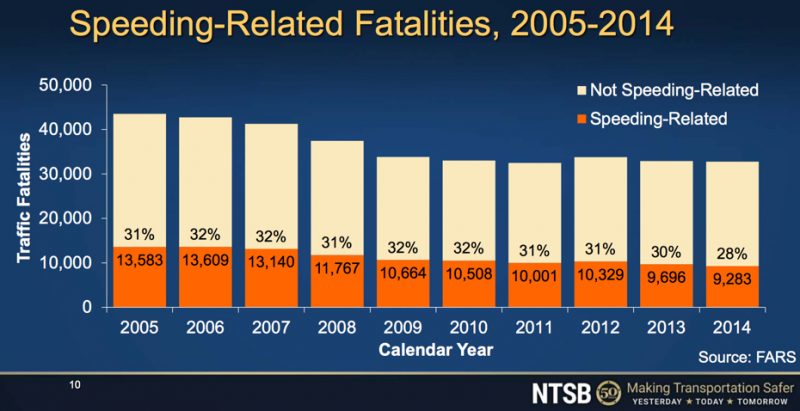
When Portland Bureau of Transportation management and staff heard about the new safety study focused on speed released by the National Transportation Safety Board on Thursday, their reaction must have been. “It’s about time!”
The report is making waves in transportation reform circles for its strong tone against the scourge of speeding and what should be done about it. The NTSB looked at crashes from 2004 through 2014 and found that speed was listed as a factor in nearly one-third of all fatal crashes. That led the NTSB’s Acting Chairman Robert L. Sumwalt to say, “You can’t tackle our rising epidemic of roadway deaths without tackling speeding.”
Here’s more from the NTSB press release:
“The NTSB found the relationship between speed and crash involvement is complex and is affected by a number of factors, however, speed – and therefore speeding – increases crash risk both in terms of the likelihood of being involved in a crash and in terms of the severity of injuries sustained by those involved in speeding-related crashes.
The study links speeding to 112,580 highway crash fatalities between 2005-2014. To put that number in perspective, nearly the same number of people – 112,948 – died in alcohol-involved crashes in the same period.
Despite this sobering statistic, speeding has few negative social consequences compared to the consequences of an arrest or conviction for driving under the influence. The study further notes that although drivers are aware that speeding is a threat to safety, they also acknowledge it is a common driving behavior in the US.”
Advertisement
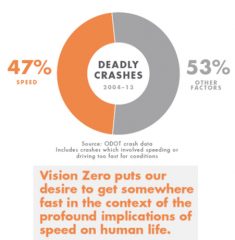
To make roads safer, the agency made 19 recommendations to various state and federal agencies. Among them were several that will sound familiar to BikePortland readers: more speed cameras, more sensible (lower) speed limits, more high-visibility enforcement actions with local police, better data about where speeding occurs, and so on. Each one of those initiatives are already things PBOT is doing in some form or another in their war on speeding and related Vision Zero efforts.
Perhaps the most notable (and exciting) takeaway from the study is how it throws hefty skepticism at the all-powerful “85th percentile” rule that the federal government (and via trickle-down engineering standards) has used to set speed limits and design roadways for half a century. “Raising speed limits to match the 85th percentile speed can result in unintended consequences,” they write. “It may lead to higher operating speeds, and thus a higher 85th percentile speed… Alternative approaches and expert systems for setting speed limits are available, which incorporate factors such as crash history and the presence of vulnerable road users such as pedestrians.” (A BikePortland commenter shared a very helpful explanation about the folly of the 85th percentile approach yesterday.)
Just how big of a deal is it that a federal, independent investigative agency like the NTSB has come out swinging against speeding? All the evidence you need is in this pointed response from the National Motorists Association, an automobile users advocacy group. They accuse the NTSB’s study as part of a “draconian” plot to, “turn our highways into a for-profit police state.”
For more on the study check out the coverage on Streetsblog.
— Jonathan Maus: (503) 706-8804, @jonathan_maus on Twitter and jonathan@bikeportland.org
Never miss a story. Sign-up for the daily BP Headlines email.
BikePortland needs your support.


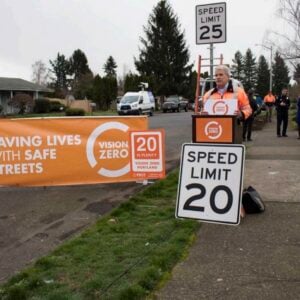
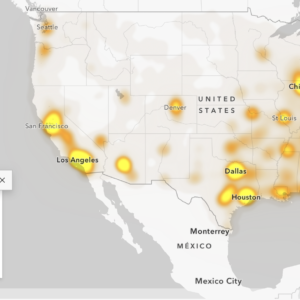

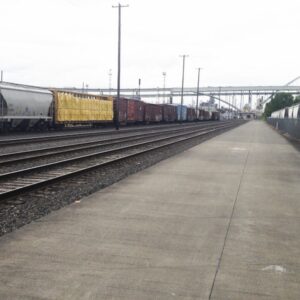
Thanks for reading.
BikePortland has served this community with independent community journalism since 2005. We rely on subscriptions from readers like you to survive. Your financial support is vital in keeping this valuable resource alive and well.
Please subscribe today to strengthen and expand our work.
Jonathan – thanks for covering this important traffic safety issue.
…and in following the link to the National Motorists Association attack on the NTSB’s speed findings they use as a source to refute the research: TheNewspaper…an interesting shadow lobby press entity I was not aware about.
TheNewspaper.com provides objective information about the politics of driving. Based in Washington, D.C., we offer news items and extensive documentation sourced from around the world.
We offer a special focus on red light and speed camera enforcement.
TheNewspaper.com is a not-for-profit site, and its editors and contributors have no financial ties to the issues discussed. We urge readers to always consider the financial interests of all sources quoted regarding traffic enforcement. In every case where it is possible to do so, we host the full text of reports and original source material. Government documents and other useful material are often removed from their own websites over time as new items are added or site design changes. Our intention is to host information in such a way that it becomes part of a permanent, organized record. Comments, tips and suggestions are always welcome using our feedback form.
What is the Politics of Driving?
TheNewspaper covers government policies that affect one of the largest segments of society today — the motoring public. There are 200 million licensed drivers in the United States, 41 million in the United Kingdom and 13 million in Australia. Policy trends that begin in one country eventually make their way to other parts of the globe. For this reason, we treat issues of transportation policy from an international, not regional, perspective.
I knew there was someone in a smoke filled room pulling the strings of the car heads
Its too hot to ride, so I picked up this topic too…
Richard Diamond was interviewed in Car & Driver back in 2011 about his decade long efforts with “TheNewspaper”, but his last TheNewspaper editorial was written in 2015…so perhaps he is doing so well to have hired news staff [from country “fill in the blank”] or has robots feeding his blog.
[Perhaps “we” can learn from his strengths on messaging a POV advocacy and make $.]
He used to write for The Washington Post then moved onto a “recent” position at The White House Writers Group [but no public posts listed for him at the WHWG…hmmm…just opinion articles for national papers: USAToday etc.]
“Media Transparency calls WHWG “an umbrella firm of former ghostwriters for Republican presidents and bureaucrats now at the service of anyone willing to pay.”[3] source SourceWatch”
http://www.whwg.com/principals/richard-diamond/
http://www.adweek.com/digital/twt-writer-lands-spread-in-car-and-driver/
http://www.popularmechanics.com/cars/a9673/10-tips-to-avoid-speeding-tickets-16106949/
https://www.mediaite.com/online/washington-times-editor-posts-traffic-cam-video-of-aurora-shooter-james-holmes-on-his-traffic-blog/
Twitter @RichardPDiamond
Thanks!
(Your web kungfu is greater than mine, oh master, said web grasshopper.) I had looked around and none of that came up. ;-(
One thing that isn’t captured in the data here is the disturbing trend of increased speed limits, primarily in rural areas, but even on some suburban roads. Several states have 80mph speed limits on highways now. A fatal crash at 80mph would not fall into the “Speed is a factor” category if it occurred on one of these highways.
A good case study is HWY 26 east of Mt. Hood. The speed limit was raised to 65mph last year, and there was a noticeable uptick in fatal crashes. Having driven this section many times, my experience was that the people going 10+ over just ratcheted it up another 5mph. Getting passed by jacked up trucks hauling large toy trailers at 75+mph is terrifying on an undivided highway.
What I read here is that it essentially boils down to the police enforcing speed limits, which neither yours nor mine have a good record of actually doing.
What I mean is, Portland has grown to the point it has about 640,000 residents within its boundaries, while Detroit has shrunk so badly that now has only slightly more people, 672,000 residents. But Portland has only 950 sworn police officers while Detroit has over 2,400. To get the level of traffic speed enforcement needed, as well as do all the other policing of a big city (including the rampant bike theft issue), Portland could reasonably expect to double the size of its police and still have fewer officers per population than Detroit, but at a huge cost. Financially, since you won’t raise your taxes, you would have to cut budgets of other city departments, even taking away parking revenue from PBOT (perfectly legal), closing parks, eliminating ONI, SEUL and EPAP, etc. Relative to the rest of the city budget, Police would be an even more huge bureaucracy. By having police everywhere enforcing speed laws, the courts would be packed, jails full, lawyers expanding employment, but at a cost of fewer open parks, no street cleaning and repair folks, fewer neighborhood events, etc. So, yeah, if Portland REALLY enforced the law and firmly implemented Vision Zero, it would very soon look more like a “police state” than most of us would feel comfortable living with.
I’m pretty sure I read the expansion of Portland PD is already heavily funded but the problem is a lack of applicants.
Yup, same as everywhere, low pay, high cost of living, get blamed for everything wrong with our society.
It always amazes me that with so many people concerned about police culture in PDX, they are not lining up to be cops so that they can change the culture 🙂
Maybe they are, but are being rejected? Portland is an odd city, full of well-educated well-read individuals who have “some college” but neither completed high school nor quite finished college. Almost every police department in the USA requires a high school diploma at a minimum, and many (including here) a college degree too.
Maybe cops could be given discounts on education – they can be a cop, do some of the duties, work their way to a degree at a discounted rate and then become a patrol person with good judgment.
“with so many people concerned about police culture in PDX, [why] they are not lining up to be cops ”
Really?
Is that how it works? Not that I’ve ever heard. I think it is pretty obvious that almost no one wants to be a cop because in many places the police have brought upon themselves a terrible reputation. And those who do, many of them, I could imagine want in for exactly the wrong reasons.
https://www.michaelawoodjr.net/
More from Michael Wood Jr.
https://www.youtube.com/watch?v=RxW6OIE4CYU
I’m sorry, but I don’t consider Portland to “be on the right track.” That involves actually DOING something. The absence of enforcement is a glaring deficiency.
As I’ve pointed out before, PPB’s own annual report indicates 50,000 interactions by the Traffic Division per year. That works out to fewer than 150 per day. Meanwhile, there are about 9 million miles driven daily by motorists in Portland’s city limits. That’s one interaction (not necessarily resulting in a citation) for every 60,000 miles driven. Enforcement is essentially non-existent. Maybe that’s why speeding is rampant; motorist blow through red lights and ignore the presence of pedestrians in crosswalks.
I’m not convinced that the 85th percentile concept is all bad. It can be used to design roads with the natural speeds we want instead of relying on enforcement that is expensive to both the folks paying for the enforcement and the recipients of that enforcement.
perhaps the deeper issue is that road design standards encourage high speeds. reducing the speed limit on a road without changing its design will just clog up traffic courts.
I do agree that ratcheting up speed limits is not a good idea.
“the natural speeds we want”
Hmmm. Who’s “we”?
My first reaction was that the numbers probably more likely reflect slower speeds due to congestion rather than improvements per se
I applaud any attention to speeding as a problem.
Ever since the Tillamook cops found that Frank Bohannon plowing into and killing Kerry Kunsman on a curvy stretch of road had ‘nothing to do with speed’ I’ve felt that very nearly all crashes we learn about, read about, get to analyze can be explained with reference to (only) two factors: speed and inattention. One or both seem to play a significant part in every crash I can think of. Why make it more complicated than it is?
So speed kills, after all? Now I don’t feel so guilty about cruising in the left lane right at the speed limit.
Don’t kid yourself. There is such a thing as flow.
Speeding is not good, but blocking traffic can cause other consequences that are significantly more dangerous.
I can’t think of a statement that more perfectly captures what Alan Durning called Car Head. The idea that speeding is not only an entitlement, but actually safer! That driving the speed limit is more dangerous…. Give me a break.
Taking vigilante action to “enforce” laws is irresponsible and dangerous.
If you purposely block cars, the consistent outcome will be cars bunched up too close to each other with obstructed vision, peoples’ attention focused on the wrong things, people trying to shoot quickly into small gaps, and creating frustration/anger that leads that worsens these effects.
Good drivers get caught in this mess too as they will be tailgated rather than passed and cut off if they try to maintain reasonable following distances. Cyclists are endangered by the driver obstructed vision and attention focused on the bumper in front rather than the totality of circumstances.
That this same situation often occurs without deliberate action does not excuse purposely endangering others — including innocent people who happen to be nearby — as the results are very predictable.
Driving safely is related to following the rules as communicated by the signs, but they are not one and the same as you should always adjust for conditions. If you don’t understand that, you have no business on the roads.
This principle of movement applies to everything, not just cars
There is nothing safe about a few slow cyclists gumming up a lane leading to everyone being bunched up because it creates the same effect on a smaller scale.
For example, if you look at the crash data http://pdx.maps.arcgis.com/apps/MapSeries/index.html?appid=cf122cd3b4ef46f0ac496b2d61d554e9 along Broadway after the bridge, you’ll see that there are very high rates of crashes at the places where cyclists bunch up at the beginning which drops off to practically nonexistent after you go a few blocks and the cycling traffic spreads out.
Broadway itself doesn’t change — the speed limit is the same, the threats from the side and are the same (actually they get worse because there’s hotel, loading, etc traffic, plus most cyclists slow down as the grade kicks up increasing the speed differential).
There’s a reason for that, and it’s because the cyclists often ride unsafely due to being bunched up at the bottom and the situation rectifies itself as they spread out. If you look at the map and are familiar with cycling dynamics in Portland, you’ll see this pattern repeated elsewhere.
Driving at or below the speed limit isn’t vigilantism, no matter how you try to spin it with your hypotheticals.
You need to operate safely, and speed is a component of that.
But if you’re using a number on a sign as a pretext to intentionally cause dangerous traffic issues that threaten innocent people unlucky enough to be in your vicinity, you are an irresponsible menace.
If you could hear yourself….
If only I could simply ride my bike at or above the posted speed limit of 30 mph, all my problems would be solved!
You like physical separation from the cars. Presumably, part of the reason is you consider the speed differential dangerous.
What makes speed differentials dangerous is that they require people to make more adjustments. The more adjustments people are required to make, the more potential for error.
The issue here is intentionally blocking. This causes erratic movement — even by those who just want to stay out of trouble. At the same time, it bunches up vehicles. Between the need to respond to more types of changes and diminished vision, drivers have less ability to respond to cyclists, peds, etc.
Driving and cycling is hard enough to do well without people purposely making things worse. When I see drivers or cyclists acting like that — and it’s all too common — I create as much distance as possible.
But I thought the VC-type people say to “take the lane”? What’s the difference between taking the lane and intentionally blocking traffic? Nearly all streets in Portland lack basic cycling infrastructure so most of the time I have to ride in the middle of the lane (outside the door zone). Am I intentionally blocking traffic and creating a dangerous situation or am I riding safely and intently?
“At the same time, it bunches up vehicles.”
You should read up on fluid dynamics.
Moderate, steady speeds are the antithesis, the best way to counteract, the kind of trouble you are imagining.
I frequently take the lane, but this is really about minimizing adjustments that others have to make. The more adjustments people have to make, the greater the chance that they fail to make one correctly. The greater the magnitude of the adjustments they need to make, the greater the consequences when they fail to do so. In general, things work best when people make lots of microadjustments rather than a few big ones because there are a lot more opportunities to act and recover from mistakes.
The idea of using the lane is to be visible so drivers have a long time (i.e. many opportunities) to adjust to you and coordinate their pass with oncoming traffic and other factors. As you know, many drivers tailgate and the best predictor of what they’re going to do next is whatever the person in front of them did — i.e. if that drivers pulls left to pass, they will follow. When you hear me talk about “herding cars,” I’m talking about riding techniques the result in that dynamic.
There are techniques you can use to calm traffic without triggering dangerous conditions and you can even get drivers to feel good about it. For example, one thing I do on fast roads (including highways where traffic is > 60mph) when I approach a pinch point is to identify a sufficiently large gap in the traffic behind that I’ll use to create space. When the vehicle at the beginning of the gap passes, I drift left — far enough to be hit. If I see the vehicle behind slow or drift over, I know the driver sees me and I’m not going to get hit. As they slow down, I drift back right and even if the pass is tight (e.g. 2 lane highway with small/no shoulder), I wave them by for a close pass. Whether or not they do, I give a friendly wave and the traffic behind does the same.
They tend to wave back — i.e. I’ve blocked them and I actually have them thanking me for it because they’re thinking of the consideration of thinking about them. I’ve used this method for many years, and it’s very effective. If the vehicle doesn’t respond to my initial drift, I hold my position as long as safe ready to take evasive action. It’s extremely rare that I can’t move them out. In practice, I wind up moving in and out a lot.
As 9watts points out, moderate, steady speeds are the best way to counteract trouble — I couldn’t agree more. If vehicular traffic is going too fast, there are techniques you can use to calm it down gradually to a sane level which prevents dangerous situations.
Kyle, I really have no idea what you’re talking about most of the time regarding techniques for property cycling. I just want drivers to be safe, that’s all. I have no desire to learn all these techniques you’re constantly expressing concerns that everyone needs to possess.
That the techniques work and make riding safer and more fun is what makes them worth figuring out.
These methods boil down to two very simple ideas. The first is that you need to constantly communicate with drivers to prevent conflicts from occurring in first place. The second is to assume drivers will do the dangerous and stupid thing. The vast majority of the time, they do the right thing, but it’s no biggie if they don’t if you’re ready for it.
If you want the drivers to be safe, the first step is to help the ones in your immediate vicinity know what to do. This means constant communication is important. It might sound like a pain, but it makes a massive difference.
The alternative is trusting your safety to others which is both scary and dangerous.
If you guys actually do this nonsense, you could get someone hurt or killed. If you get stuck in a situation where someone else is doing this, the person being hurt or killed could be you. Good thing most people on this blog don’t drive much.
It’s crystal clear to me that a lot of people here are willing to ride a bike unsafely when they can claim they are legally right. That they continue this behavior behind the wheel shouldn’t be a surprise.
Nonsense? I’m just riding my bike at the speed I am able to. This condescending attitude towards those less strong than you is getting tiring.
This has nothing to do with speed. It’s about riding appropriately for conditions (which includes your equipment and abilities)
I frequently ride up shoulderless roads at less than 10mph for both utility and recreational riding. The weekend after next, I’m going to ride around Crater Lake on a recumbent trike with a buddy who is in his mid 50’s and weighs well over 200lbs — a lot of the time, we’ll only be going about 6mph. If you’re not familiar with the road, it has a lot of big vehicles and distracted drivers on it and it lacks shoulders.
I’ve been riding with this guy for decades and we never have problems. There’s a reason for that. And it’s neither strength nor speed.